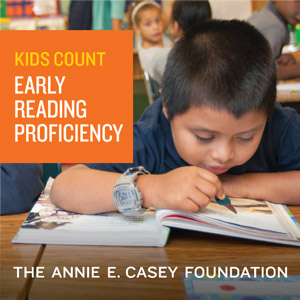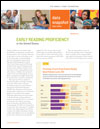Georgia 4th-grade Reading Scores Improve
Print This PostBut Widening Proficiency Gap Threatens Georgia’s Future Prosperity
 |
A KIDS COUNT data snapshot released today by the Annie E. Casey Foundation warns that the proficiency gap between low- and high-income children is increasing in Georgia and across the nation.
According to new data from the National Center for Education Statistics, over the past decade, Georgia—and most other states across the country—saw early reading scores improve, but progress is slow. In 2013, two out of three children in Georgia could not read on grade level when they entered fourth grade. Beyond that, 80 percent of low-income children are reading below proficiency and continuing to fall behind their more affluent peers. That rate mirrors the national trend.
“We know grade-level reading is a predictor of a student’s future academic and economic success, and children who fall behind early rarely make up ground in later grades,” warns Gaye Smith, executive director of Georgia Family Connection Partnership (GaFCP). “In an economy that increasingly demands skilled workers, lack of educational success poses risks for children who fall behind early—and for our state economy.”
The encouraging news is that between 2003 and 2013, Georgia saw a 10-percent increase in students reading at or above proficiency—the ninth-best improvement among all states. The rate of students who read below a proficient level fell from 73 to 66 percent during those years.
Despite this progress, however, the proficiency gap between low-income students and high-income students in Georgia has increased by 23 percent over the past decade compared to 19 percent for the rest of the nation. In 2013, 47 percent of high-income students read below proficient levels, compared with 79 percent of low-income students.
“As demographics change in both Georgia and the nation, it is essential that we close achievement gaps,” said Smith.
In addition to the growing income-based proficiency gap, the Casey report also cites a reading gap between racial/ethnic minorities and white students. New data shows that the gap between white and minority students in Georgia—specifically black students and Hispanic students—may be narrowing, but the disparity persists.
“The improvement in Georgia’s fourth-grade reading scores is a positive indication that Georgia has identified—and is implementing—effective strategies and practices,” said Garry McGiboney, deputy superintendent of External Affairs at the Georgia Dept. of Education. “However, the widening literacy gap between low- and high-income students is a strong message that we must reach deeper into the challenges and identify all the factors that have an impact on reading, such as access to health care, nutrition, early language development, and school climate.”
Clarke County School District Superintendent Philip Lanoue agrees. “It’s clear we are making progress, as evidenced by Georgia’s 4th-grade NAEP reading scores,” he said. “But the barriers our economically disadvantaged and minority students are up against show that we, as a state, must expand our efforts to ensure all students are achieving.”
In recent years, the Casey Foundation produced two reports on early learning and grade level reading. Early Warning: Why Reading by the End of Third Grade Matters and Early Warning Confirmed show that children who read proficiently by the end of third grade are more likely to graduate from high school, are less likely to fall into poverty, and are more likely to find a job that can adequately support their families.
“The literacy gap is a crisis for all Georgians and the consequences are serious,” said Arianne Weldon, director of the Georgia Campaign for Grade-Level Reading. “In response, an unprecedented coalition has come together representing hundreds of public and private partners, community groups, and advocates, and in March we will launch a statewide campaign to get Georgia reading.”
 |
Read the Annie E. Casey Data Snapshot: “Early Reading Proficiency in the United States” |
Contact:
Rebecca Rice
Georgia KIDS COUNT Coordinator
404-527-7394 (x103)
rebecca@gafcp.org
Bill Valladares
GaFCP Communications Director
404-527-7394 (x113)
william@gafcp.org
Follow us on Twitter @gafcpnews.
For interactive statewide data, visit Georgia KIDS COUNT at gafcp.org/kidscount.
Georgia Family Connection Partnership (GaFCP) is a public-private partnership created by the State of Georgia and funders from the private sector to assist communities in addressing the serious challenges facing children and families. GaFCP also serves as a resource to state agencies across Georgia that work to improve the conditions of children and families. Georgia KIDS COUNT provides policymakers and citizens with current data they need to make informed decisions regarding priorities, services, and resources that impact Georgia’s children, youth, families, and communities. Georgia KIDS COUNT is funded, in part, through a grant from The Annie E. Casey Foundation, a private charitable organization dedicated to helping build better futures for disadvantaged children in the United States.
The KIDS COUNT Data Center is a comprehensive source of information where you can download this year’s complete Data Book and access the new mobile site being launched using your smart phone.
